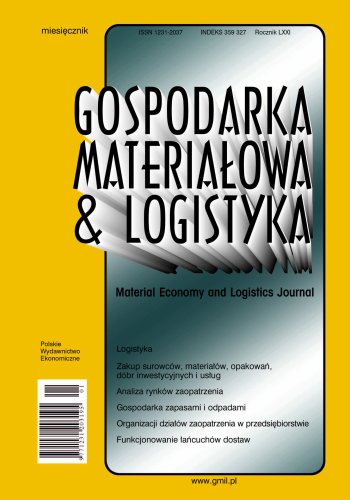Appropriation of the network rent in a triadic supply chain
Most often, the contemporary supply chains are nowadays analyzed from the perspective of triadic arrangements, which brings an understanding of the complexity and dynamics of changes in inter-organizational structures. In this paper, the structural hole and closure as two basic forms of triads are depicted to elaborate on the emergence of network rent in supply chains, as the uneven distribution of network rent derived from the inter-organizational structures is still a vital issue. The goal of this paper is thus to identify and explain the phenomenon of network rent appropriation in triadic supply chains. Likewise, the paper seeks to recognize the possibility of estimating network rent in supply chains.
References
Bibliografia/References
Bromiley, P., Rau, D. (2014). Towards a practice-based view of strategy. Strategic Management Journal, 35(8), 1249–1256. https://doi.org/10.1002/smj.2238
Burt, R. S. (1992). Structural Holes. Cambridge, Massachusetts: Harvard University Press.
Burt, R. S. (1997). The Contingent Value of Social Capital. Administrative Science Quarterly, 42(2), 339–365. https://doi.org/10.2307/2393923
Burt, R. S. (2000). The network structure of social capital. Research in Organizational Behaviour, 22, 345–423.
Carter, C. R., Kosmol, T., Kaufmann, L. (2017). Toward a Supply Chain Practice View. Journal of Supply Chain Management, 53(1), 114–122. https://doi.org/10.1111/jscm.12130
Chae, S. (2018). Horizontal versus vertical structural holes in supply networks: Contrasting performance implications for focal firms, Proceedings of the 20th EurOMA Conference, 24–26 June, Budapest.
Choi, T. Y., Wu, Z. (2009a). Triads in supply networks: theorizing buyer-supplier-supplier relationships. Journal of Supply Chain Management, 45(1), 8–25. https://doi.org/10.1111/j.1745-493x.2009.03151.x
Choi, T. Y., Wu, Z. (2009b). Taking the leap from dyads to triads: Buyer-supplier relationships in supply networks. Journal of Purchasing and Supply Management, 15(4), 263–266. https://doi.org/10.1016/j.pursup.2009.08.003
Coleman, J. S. (1988). Social Capital in the Creation of Human Capital. American Journal of Sociology, 94, 95–120.
Coleman, J. S. (1990). Foundations of Social Theory. Cambridge, MA: Harvard University Press.
Cooper, M. C., Ellram, L. M., Gardner, J. T., Hanks, A. M. (1997). Meshing multiple alliances. Journal of Business Logistics, 18(1), 67–89.
Czakon, W. (2012). Sieci w zarządzaniu strategicznym. Warszawa: Wolters Kluwer.
Duschek, S. (2004). Inter-firm resources and sustained competitive advantage. Management Review, 15(1), 53–73. https://doi.org/10.5771/0935-9915-2004-1-53
Dyer, J. H., Singh, H. (1998). The relational view: cooperative strategy and sources of interorganizational competitive advantage. Academy of Management Review, 23(4), 660–679. https://doi.org/10.5465/amr.1998.1255632
Ellram, L. M., Cooper, M. C. (1993). The relationship between Supply Chain Management and Keiretsu. International Journal of Logistics Management, 4(1), 1–12. https://doi.org/10.1108/09574099310804911
Håkansson, H., Persson, G. (2004). Supply Chain Management: The logic of supply chains and networks. International Journal of Logistics Management, 15(1), 11–26. https://doi.org/10.1108/09574090410700202
Kogut, B. (2000). The network as knowledge: generative rules and the emergence of structure. Strategic Management Journal, 21, 405–425. https://doi.org/10.1002/(sici)1097-0266(200003)21:3<405::aid-smj103>3.0.co;2-5
Lavie, D. (2006). The competitive advantage of interconnected firms: An extension of the Resource-Based View. Academy of Management Review, 31(3), 638–658. https://doi.org/10.5465/amr.2006.21318922
Li, M., Choi, T. Y. (2009). Triads in services outsourcing: bridge, bridge decay and bridge transfer. Journal of Supply Chain Management, 45, 27–39. https://doi.org/10.1111/j.1745-493x.2009.03169.x
Mańkowski, C. (2010). Synergia w logistyce. Gdańsk: Wydawnictwo Uniwersytetu Gdańskiego.
Mena, C., Humphries, A., Choi, T. Y. (2013). Toward a theory of Multi-Tier Supply Chain Management. Journal of Supply Chain Management, 49(2), 58–77. https://doi.org/10.1111/jscm.12003
Mentzer, J. T., DeWitt, W., Keebler, J. S., Min, S., Nix, N. W., Smith, C. D., Zacharia, Z. G. (2001). Defining Supply Chain Management. Journal of Business Logistics, 22, 1–25. https://doi.org/10.1002/j.2158-1592.2001.tb00001.x
Mitręga, M. (2010). Zdolność sieciowa jako czynnik przewagi konkurencyjnej na rynku przedsiębiorstw. Katowice: Wydawnictwo Akademii Ekonomicznej w Katowicach.
Niemczyk, J. (2013). Strategia. Od planu do sieci. Wrocław: Wydawnictwo Uniwersytetu Ekonomicznego we Wrocławiu.
Obstfeld, D. (2005). Social networks, the tertius iungens orientation, and involvement in innovation. Administrative Science Quarterly, 50, 100–130. https://doi.org/10.2189/asqu.2005.50.1.100
Shaw, S., Grant, D. B., Mangan, J. (2021). A supply chain practice-based view of enablers, inhibitors and benefits for environmental supply chain performance measurement. Production Planning & Control, 32(5), 382–396. https://doi. org/10.1080/09537287.2020.1737977.
Sołtysik, A. (2003), Zarządzanie logistyczne. Katowice: Wydawnictwo Akademii Ekonomicznej w Katowicach.
Świerczek, A. (2020a). Konceptualizacja roli zakorzenienia społecznego w osiąganiu sieciowej przewagi konkurencyjnej triadycznych łańcuchów dostaw. Gospodarka Materiałowa i Logistyka, (1), 2–10. https://doi.org/10.33226/1231-2037.2020.1.1
Świerczek, A. (2020b). Dynamika kształtowania więzi sieciowych w łańcuchu dostaw. Perspektywa triadyczna. Gospodarka Materiałowa i Logistyka, (10), 2–11. https://doi.org/10.33226/1231-2037.2020.10.1
Wu, Z., Choi, T. Y. (2005). Supplier-supplier relationships in the buyer-supplier triad: Building theories from eight case studies. Journal of Operations Management, 24(1), 27–52. https://doi.org/10.1016/j.jom.2005.02.001
Wynstra, F., Spring, M., Schoenherr, T. (2015). Service triads: A research agenda for buyer-supplier-customer triads in business services. Journal of Operations Management, 35, 1–20. https://doi.org/10.1016/j.jom.2014.10.002

